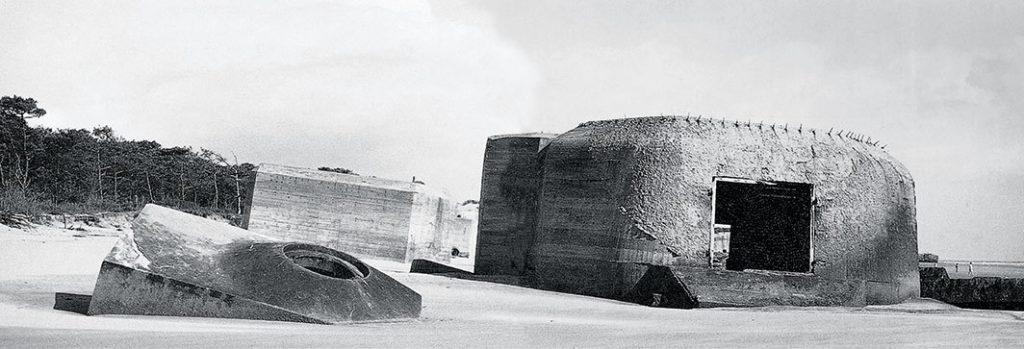
Bunker, France, ca. 1958–65. Photo: Paul Virilio
This week I’ve been reading Virilio’s Bunker Archaeology (1967), a collection of texts and photographs documenting his research and visits to the military bunkers of the Atlantikwall along France’s northwest coast. Spanning coasts from northern Norway to Spain, the Atlantikwall consisted of 15,000 bunkers built to conceal radar stations, submarine pens, and various military arsenal.
He reflects on what it feels like to enter one of these ominous monolithic spaces and the relationship between death, tombs and military architecture.
‘I was more impressed by a feeling, internal and external, of being immediately crushed. The battered walls sunk into the ground gave this small blockhouse a solid base; a dune had invaded in the interior space and the thick layer of sand over the wooden floor made the place ever narrower. Some clothes and bicycles had been hidden here; the object no longer made the same sense, though there was still some protection here. A complete series of cultural memories came to mind: the Egyptian mastabas, the Etruscan tombs, the Aztec structures . . . as if this piece of artillery fortification could be identified as a funeral ceremony…’ (p11).
He describes trapdoors in cement floors leading to crypts packed with ammunition, round or hexagonal inner chambers, and often the placement of what alludes to a religious alter or plinth in the centre of the space.
“The bunker was built in relationship to this new climate; its restrained vo1lume, its rounded or flattened angles, the thickness of its walls, the embrasure systems, the various types of concealment for its rare openings; its armour plating, iron doors, and air filters – all this depicts another military space, a new climactic reality” (p39).
I also found it interesting to read his thoughts around the relationship between territorial representation (maps, satellite views) and military expansion. He writes about these representations being strategies of military control – satilletes and radar systems – and desires around ‘controlling expanding territory, of scanning it in all directions (and, as of now, in three dimensions)’ (p17).
“The “conquest of space” by military and scientific personnel is no longer, as it once was, the conquest of the human habitat but the discovery of an original continuum thar has only a distant Iink to geographical reality.”
Another thought I had whilst reading this was the act of fortification and what it means to use the earth’s material itself and underground locations as a kind of barrier. It’s making me think of the subconscious and how the spatiality of physical spaces can have psychological connotations and interpretations. Also, what it means for the decision-making processes and the actions that are expected to happen at these sites.
“The fortification is a special construction; one does not live there, one executes particular actions there, at a particular moment, during a conflict or in a troubled period” (p42).